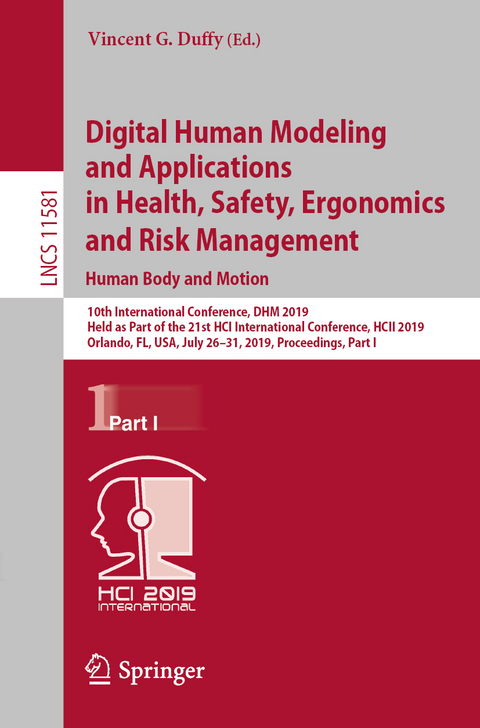
Digital Human Modeling and Applications in Health, Safety, Ergonomics and Risk Management. Human Body and Motion
Springer International Publishing (Verlag)
978-3-030-22215-4 (ISBN)
The total of 1275 papers and 209 posters included in the 35 HCII 2019 proceedings volumes were carefully reviewed and selected from 5029 submissions.
DHM 2019 includes a total of 77 papers; they were organized in topical sections named:
Part I, Human Body and Motion: Anthropometry and computer aided ergonomics; motion prediction and motion capture; work modelling and industrial applications; risk assessment and safety.
Part II, Healthcare Applications: Models in healthcare; quality of life technologies; health dialogues; health games and social communities.
Anthropometry & Computer Aided Ergonomics.- A Comparison between Virtual Reality and Digital Human Modeling for Proactive Ergonomic Design.- Comparison of Digital Human Model -based Ergonomic Software using Eye-Tracking Methodology - Presenting Pilot Usability Tests.- A Full-chain OpenSim Model and its Application on Posture Analysis of an Overhead Drilling Task.- Design and Evaluation of the System Device for Mitigation of the Low Back Pain Among Veterinarians.- Research on Body Pressure Distribution of Office Chair with Different BMI.- Design Method of 3D-Printable Ergonomically Personalized Stabilizer.- Size North America - the new North American Anthropometric Survey.- Research on the Characteristic and Gender Differences in Adult Foot Shape in China.- Motion Prediction and Motion Capture.- Exploring the Feasibility of Classifying Fundamental Locomotor Skills Using an Instrumented Insole and Machine Learning Techniques.- Classifying Non-elementary Movements In Vietnamese Mo Dances.- Periodicity Detection of Quasi-periodic Slow-speed Gait Signal using IMU sensor.- Using Foot and Knee Movement and Posture Information to Mitigate the Probability of Injuries in Functional Training.- Extraction of the Graceful Feature from Classical Dance Motion focused on Dancer's Perspective.- Homologous Mesh Extraction via Monocular Systems.- Machine Learning to estimate the amount of training to learn a motor skill.- Capture of stability and coordination indicators in virtual training scenarios for the prevention of slip, trip, and fall (STF) accidents.- Effect of Selective Training Device in the Mono-Articular Muscle of Lower Limbs.- Work modelling and industrial applications.- The Neuroeducational Principles of the SEE BEYOND Method Applied on the Materialization of a Fashion Collection Designed by Visually Impaired Fashion Designers.- First impressions and acceptance of order pickers towards using data glasses at a simulated workstation.- Continuous measurement of muscle fatigue using wearable sensors during light manual operations.- Level of Robot Autonomy and Information Aids in Human-Robot Interaction affect Human Mental Workload - an Investigation in Virtual Reality.- OSH and the Future of Work: Benefits & Risks of Artificial Intelligence tools in workplaces.- Cooperation between Design and Neuroscience: contributions to current project methodologies applied to Automotive Design.- An integrated ergonomics evaluation method of HWDs.- Evaluation of the advising doctor for operating of medical student by laparoscopic surgery simulator.- Research on Path Planning Algorithm for Two-Dimensional Code Guidance Model of Automated Guided Vehicle.- Risk assessment and safety.- A framework to quantitatively assess safety performance for civil aviation organization.- Modeling Vehicle-Pedestrian Encountering Risks in the Natural Driving Environment using Machine Learning Algorithms.- Innovative and Comprehensive Support System for TrainingPeople Working in Dangerous Conditions.- Development and Evaluation of a Tablet-Control for a Surgical Workstation in the Open Integrated Operating Room.- Developing Real-time Face Identification Device Composable with Distributed Applications.- An Integrated Approach of Multiple Correspondences Analysis (MCA) and Fuzzy AHP method for Occupational Health and Safety Performance Evaluation in the Land Cargo Transportation.- The relevance of cybersecurity for functional safety and HCI.- Highway End-of-Queue Alerting System Based on Probe Vehicle Data.- Creating and Testing Objective Performance Metrics for the Manual Teleoperation of Robotic Arms.- A Method of Designing Outdoor Safety Way Guidance Sign Layout Information Based on Human Factors Engineering.- Memories and Brain Maps: representations of fear, risk and insecurity in downtown areas.
| Erscheinungsdatum | 21.06.2019 |
|---|---|
| Reihe/Serie | Information Systems and Applications, incl. Internet/Web, and HCI | Lecture Notes in Computer Science |
| Zusatzinfo | XXIV, 528 p. 284 illus., 236 illus. in color. |
| Verlagsort | Cham |
| Sprache | englisch |
| Maße | 155 x 235 mm |
| Gewicht | 836 g |
| Themenwelt | Mathematik / Informatik ► Informatik ► Betriebssysteme / Server |
| Mathematik / Informatik ► Informatik ► Netzwerke | |
| Informatik ► Software Entwicklung ► User Interfaces (HCI) | |
| Informatik ► Theorie / Studium ► Künstliche Intelligenz / Robotik | |
| Schlagworte | Applications • Artificial Intelligence • computer aided ergonomics • Computer Science • conference proceedings • Data communication systems • Education • HCI • Healthcare • Human-Computer interaction • Human engineering • Industrial Applications • Informatics • mobile computing • Motion Planning • Research • risk assessment • Robotics • robots • Semantics • sensors • Telecommunication networks • Usability Engineering • User Interfaces • World Wide Web |
| ISBN-10 | 3-030-22215-2 / 3030222152 |
| ISBN-13 | 978-3-030-22215-4 / 9783030222154 |
| Zustand | Neuware |
| Haben Sie eine Frage zum Produkt? |
aus dem Bereich


